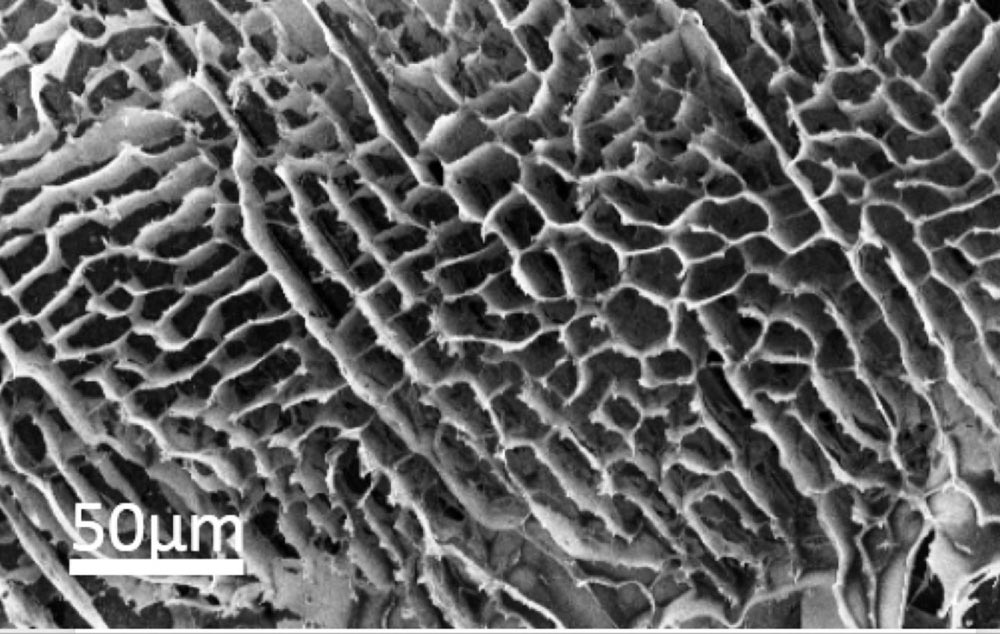
Boron Nitride Foam: A Breakthrough in Carbon Dioxide Absorption

A microscope image shows the high surface area of hexagonal-boron nitride foam glued together with polyvinyl alcohol. The tough, light foam can be used to soak up carbon dioxide or as a material to shield biological tissues from lasers.
Credit: Ajayan Research Group/Rice University
Rice University materials scientists have created a light foam from two-dimensional sheets of hexagonal-boron nitride (h-BN) that absorbs carbon dioxide.
They discovered freeze-drying h-BN turned it into a macro-scale foam that disintegrates in liquids. But adding a bit of polyvinyl alcohol (PVA) into the mix transformed it into a far more robust and useful material.
The foam is highly porous and its properties can be tuned for use in air filters and as gas absorption materials, according to researchers in the Rice lab of materials scientist Pulickel Ajayan.
Their work appears in the American Chemical Society journal ACS Nano.
The polyvinyl alcohol serves as a glue. Mixed into a solution with flakes of h-BN, it binds the junctions as the microscopic sheets arrange themselves into a lattice when freeze-dried. The one-step process is scalable, the researchers said.
“Even a very small amount of PVA works,” said co-author and Rice postdoctoral researcher Chandra Sekhar Tiwary. “It helps make the foam stiff by gluing the interconnects between the h-BN sheets – and at the same time, it hardly changes the surface area at all.”
In molecular dynamics simulations, the foam adsorbed 340 percent of its own weight in carbon dioxide. The greenhouse gas can be evaporated out of the material, which can be reused repeatedly, Tiwary said. Compression tests showed the foam got stiffer through 2,000 cycles as well.
And when coated with PDMS, another polymer, the foam becomes an effective shield from lasers that could be used in biomedical, electronics and other applications, he said.
Ultimately, the researchers want to gain control over the size of the material's pores for specific applications, like separating oil from water. Simulations carried out by co-author Cristiano Woellner, a joint postdoctoral researcher at Rice and the State University of Campinas, Brazil, could serve as a guide for experimentalists.
“It's important to join experiments and theoretical calculations to see the mechanical response of this composite,” Woellner said. “This way, experimentalists will see in advance how they can improve the system.”
Rice graduate student Peter Owuor is lead author of the paper. Co-authors are Ok-Kyung Park, a visiting scholar at Rice and a postdoctoral researcher at Chonbuk National University, Republic of Korea; Rice postdoctoral researchers Almaz Jalilov and Rodrigo Villegas Salvatierra and graduate students Luong Xuan Duy, Sandhya Susarla and Jarin Joyner; Rice alumnus Sehmus Ozden, now a postdoctoral fellow at Los Alamos National Laboratory; Robert Vajtai, a senior faculty fellow at Rice; Jun Lou, a Rice professor of materials science and nanoengineering; and James Tour, Rice's T.T. and W.F. Chao Chair in Chemistry as well as a professor of computer science and of materials science and nanoengineering; and Professor Douglas Galvão of the State University of Campinas. Ajayan is chair of Rice's Department of Materials Science and NanoEngineering, the Benjamin M. and Mary Greenwood Anderson Professor in Engineering and a professor of chemistry.
The Air Force Office of Scientific Research and its Multidisciplinary University Research Initiative funded the research.
Read the abstract at http://pubs.
DOI: 10.1021/acsnano.7b03291
This news release can be found online at http://news.
Follow Rice News and Media Relations via Twitter @RiceUNews
Video:
CAPTION: A molecular dynamics simulation shows carbon dioxide (red and teal) molecules being adsorbed by a hexagonal-boron nitride (yellow and blue) foam held together by polyvinyl alcohol (white). Researchers at Rice created a macroscale foam that may be useful for capturing carbon dioxide. (Credit: Cristiano Woellner/Rice University/State University of Campinas)
Related materials:
Tough foam from tiny sheets: http://news.
Ajayan Research Group: http://ajayan.
Galvão bio: http://www.
Rice Department of Materials Science and NanoEngineering: https:/
Images for download:
http://news.
Blocks of hexagonal-boron nitride foam treated with polyvinyl alcohol proved able to adsorb more than three times its weight in carbon dioxide. The reusable material was created at Rice University. (Credit: Ajayan Research Group/Rice University)
http://news.
A microscope image shows the high surface area of hexagonal-boron nitride foam glued together with polyvinyl alcohol. The tough, light foam can be used to soak up carbon dioxide or as a material to shield biological tissues from lasers. (Credit: Ajayan Research Group/Rice University)
http://news.
A molecular dynamics simulation shows polyvinyl alcohol molecules of carbon (teal), oxygen (red) and hydrogen (white) binding two-dimensional sheets of hexagonal-boron nitride (blue and yellow). The reusable material created at Rice University can sequester more than three times its weight in carbon dioxide. (Credit: Ajayan Research Group/Rice University)
Located on a 300-acre forested campus in Houston, Rice University is consistently ranked among the nation's top 20 universities by U.S. News & World Report. Rice has highly respected schools of Architecture, Business, Continuing Studies, Engineering, Humanities, Music, Natural Sciences and Social Sciences and is home to the Baker Institute for Public Policy. With 3,879 undergraduates and 2,861 graduate students, Rice's undergraduate student-to-faculty ratio is 6-to-1. Its residential college system builds close-knit communities and lifelong friendships, just one reason why Rice is ranked No. 1 for quality of life and for lots of race/class interaction and No. 2 for happiest students by the Princeton Review. Rice is also rated as a best value among private universities by Kiplinger's Personal Finance. To read “What they're saying about Rice,” go to http://tinyurl.
Jeff Falk
713-348-6775
jfalk@rice.edu
Mike Williams
713-348-6728
mikewilliams@rice.edu












